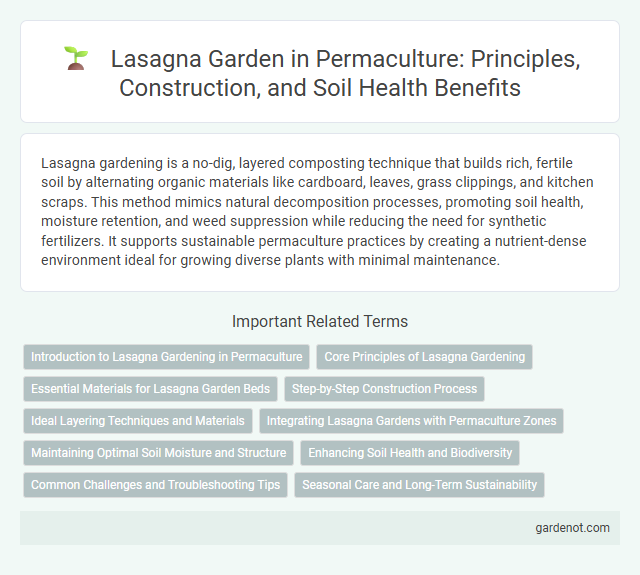Lasagna gardening is a no-dig, layered composting technique that builds rich, fertile soil by alternating organic materials like cardboard, leaves, grass clippings, and kitchen scraps. This method mimics natural decomposition processes, promoting soil health, moisture retention, and weed suppression while reducing the need for synthetic fertilizers. It supports sustainable permaculture practices by creating a nutrient-dense environment ideal for growing diverse plants with minimal maintenance.
Introduction to Lasagna Gardening in Permaculture
Lasagna gardening, a staple in permaculture, involves layering organic materials to create nutrient-rich soil, mimicking natural forest floors. This no-dig technique reduces soil compaction, enhances water retention, and boosts microbial activity essential for healthy plant growth. Utilizing kitchen scraps, leaves, grass clippings, and compost, lasagna gardening supports sustainable food production by improving soil fertility and structure without synthetic inputs.
Core Principles of Lasagna Gardening
Lasagna gardening utilizes the core principles of permaculture by layering organic materials to enhance soil fertility and moisture retention, mimicking natural forest floor processes. This method emphasizes no-till soil building, promoting biodiversity through diverse, nutrient-rich layers such as compost, leaves, and grass clippings. The strategy reduces waste, improves soil structure, and supports sustainable plant growth, aligning with regenerative agriculture practices.
Essential Materials for Lasagna Garden Beds
Lasagna garden beds require layers of carbon-rich materials such as dried leaves, straw, and shredded newspaper, combined with nitrogen-rich elements like kitchen scraps, grass clippings, and coffee grounds to create nutrient-dense soil. Essential materials include compost or aged manure to boost microbial activity and promote decomposition, along with soil or finished compost to cap the layers, fostering a fertile growing environment. Proper layering ensures moisture retention, aeration, and balanced nutrient availability critical for plant health in permaculture systems.
Step-by-Step Construction Process
Creating a lasagna garden begins by layering organic materials like cardboard or newspaper to suppress weeds, followed by alternating layers of green nitrogen-rich matter such as grass clippings with brown carbon-rich materials like straw or dried leaves. Each layer should be moistened to promote decomposition, building up to a depth of 8-12 inches to create a nutrient-rich growing medium. The final step involves topping the layers with compost and finished soil to foster healthy plant growth and ensure sustainable, fertile conditions.
Ideal Layering Techniques and Materials
Lasagna gardening utilizes ideal layering techniques by alternating carbon-rich materials such as dried leaves, straw, and cardboard with nitrogen-rich layers like grass clippings, kitchen scraps, and green manure to create nutrient-dense, decomposing organic matter. Incorporating woody stems and small branches at the bottom improves drainage and aeration while top layers of compost and mulch retain moisture and suppress weeds. This strategic layering mimics natural forest ecosystems, promoting healthy soil structure and sustainable plant growth in permaculture designs.
Integrating Lasagna Gardens with Permaculture Zones
Lasagna gardens enhance permaculture zones by layering organic materials to build nutrient-rich, self-sustaining soil beds that promote biodiversity and water retention. Positioned strategically within zones 1 or 2, these gardens optimize space for intensive cultivation of herbs and vegetables, reducing the need for external inputs. This integration supports efficient resource cycling and mimics natural ecosystems, crucial principles in permaculture design.
Maintaining Optimal Soil Moisture and Structure
Lasagna gardens maintain optimal soil moisture through layered organic materials that retain water while promoting aeration and drainage. The alternating layers of compost, leaves, and straw gradually decompose, enhancing soil structure and nutrient availability. This method supports healthy root development and reduces the need for frequent watering in permaculture systems.
Enhancing Soil Health and Biodiversity
Lasagna gardening layers organic materials such as compost, straw, and kitchen scraps to create nutrient-rich, well-aerated soil that boosts microbial activity and enhances soil health. This method promotes biodiversity by supporting diverse soil organisms, beneficial insects, and plant varieties, leading to a resilient ecosystem. Improved soil structure and moisture retention contribute to sustainable plant growth and long-term fertility in permaculture systems.
Common Challenges and Troubleshooting Tips
Lasagna gardens often face challenges such as slow decomposition of materials, which can be mitigated by shredding organic layers and maintaining moisture levels. Pest management is critical, with methods like companion planting and natural predators helping to reduce insect infestations. Monitoring nutrient balance through regular compost addition prevents soil depletion and supports healthy plant growth.
Seasonal Care and Long-Term Sustainability
Lasagna gardens require seasonal care through regular layering of organic materials such as compost, leaves, and grass clippings to maintain nutrient-rich soil and optimize moisture retention. Mulching in spring and fall helps regulate soil temperature and suppress weeds, promoting healthier plant growth. Long-term sustainability is achieved by continuous recycling of natural waste, fostering biodiversity, and encouraging beneficial microbial activity for resilient ecosystem support.
Lasagna garden Infographic

 gardenot.com
gardenot.com